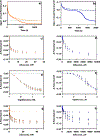Versatile potentiometric metabolite sensing without dioxygen interference
- PMID: 35032843
- PMCID: PMC8851596
- DOI: 10.1016/j.bios.2021.113888
Versatile potentiometric metabolite sensing without dioxygen interference
Abstract
The field of electrochemical biosensors has been dominated by amperometric and voltammetric sensors; however, these are limited greatly in their signal dependence on electrode size. Open circuit potentiometric sensors are emerging as an alternative due to their signal insensitivity to electrode size. Here, we present a second-generation biosensor that uses a modified chitosan hydrogel to entrap a dehydrogenase or other oxidoreductase enzyme of interest. The chitosan is modified with a desired electron mediator such that in the presence of the analyte, the enzyme will oxidize or reduce the mediator, thus altering the measured interfacial potential. Using the above design, we demonstrate a swift screening method for appropriate enzyme-mediator pairs based on open circuit potentiometry, as well as the efficacy of the biosensor design using two dehydrogenase enzymes (FADGDH and ADH) and peroxidase. Using 1,2-naphthoquinone as the mediator for FADGDH, dynamic ranges from 0.1 to 50 mM glucose are achieved. We additionally demonstrate the ease of fabrication and modification, a lifetime of ≥28 days, insensitivity to interferents, miniaturization to the microscale, and sensor efficacy in the presence of the enzyme's natural cofactor. These results forge a foundation for the generalized use of potentiometric biosensors for a wide variety of analytes within biologically-relevant systems where oxygen can be an interferent.
Keywords: Alcohol dehydrogenase; FAD-Dependent glucose dehydrogenase; Open circuit potential; Peroxidase; Second-generation biosensor.
Copyright © 2021 Elsevier B.V. All rights reserved.
Conflict of interest statement
We declare no competing financial interest.
Figures






References
-
- Baez JF, Compton M, Chahrati S, Canovas R, Blondeau P, Andrade FJ, 2020. Anal. Chim. Acta 1097, 204–213. - PubMed
-
- Boussema F, Gross AJ, Hmida F, Ayed B, Majdoub H, Cosnier S, Maaref A, Holzinger M, 2018. Biosens. Bioelectron. 109, 20–26. - PubMed
-
- Chen H, Simoska O, Lim K, Grattieri M, Yuan M, Dong F, Lee YS, Beaver K, Weliwatte S, Gaffney EM, Minteer SD, 2020. Chem. Rev. 120, 12903–12993. - PubMed
MeSH terms
Substances
Grants and funding
LinkOut - more resources
Full Text Sources

